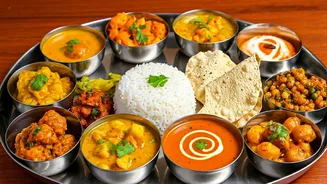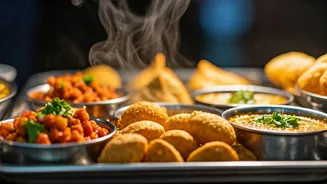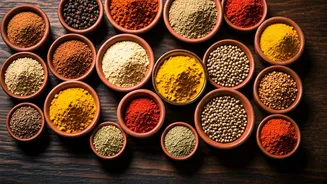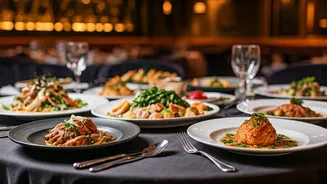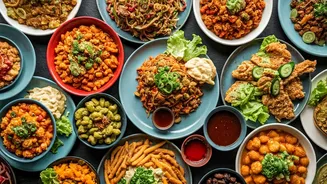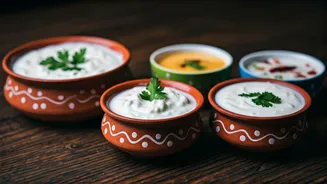Butter Chicken's Story
Butter Chicken, or Murgh Makhani, is an iconic dish that exemplifies the creamy, rich flavors of North Indian cuisine. Its creation is credited to Kundan
Lal Gujral, a chef at the Moti Mahal restaurant in Delhi, who purportedly invented it to salvage leftover tandoori chicken. The dish is known for its smooth tomato-based gravy, enriched with butter and cream, that encapsulates tender pieces of chicken. The magic of Butter Chicken lies in its perfect balance of sweet, savory, and tangy flavors. The chicken is typically marinated in yogurt and spices before being cooked in the tandoor, which lends it a smoky flavor. The resulting dish is a popular and comforting classic, enjoyed across India and the globe. This dish is usually served with naan or roti, perfect for scooping up the luscious gravy.
Biryani: A Fusion
Biryani is another star of Indian cuisine, famed for its aromatic rice and flavorful meats or vegetables. Its origins can be traced to Persia, and over centuries, it evolved throughout India, absorbing local influences. Every region of India has its unique take on biryani. Hyderabad and Lucknow are particularly famous for their distinct styles. Hyderabad Biryani often features a spicy, tangy flavor profile, with the meat marinated in yogurt and a blend of spices. Lucknowi Biryani, on the other hand, is known for its delicate flavors and subtle spices, giving it a gentle taste. Key ingredients include basmati rice, which gives the dish its long grains and wonderful aroma, along with a medley of aromatic spices like saffron, cardamom, cloves, and cinnamon. These spices blend to create an unforgettable taste that has earned Biryani a place among the world's favorite dishes. This amazing dish is often served with raita, a yogurt-based side dish.
Dosa: A South Delight
Dosa, a crispy crepe made from fermented rice and lentil batter, is a breakfast staple in South India. It's a light yet filling dish, and its versatility allows for many variations. Dosas can be served plain, or filled with savory mixtures. The classic dosa is a thin, golden-brown crepe, often served with sambar, a lentil-based vegetable stew, and coconut chutney. Masala dosa is a popular variation, filled with a spiced potato mixture. There are many other varieties to explore, including paper dosas (thin and crispy), rava dosas (made with semolina), and onion dosas. The process of making a dosa starts with soaking rice and lentils, then grinding them into a batter. This batter is then fermented, giving the dosa its slightly tangy flavor and light texture. Cooking the dosa involves spreading the batter thinly on a hot griddle, and then allowing it to cook until it's crispy. The aroma of a freshly made dosa wafting through the air is a delight. Dosas are not just a food item; they are a culinary experience that represents the flavors and culture of South India.
Samosa's Popularity
Samosas, the deep-fried, triangular savory pastries, are a beloved snack across India. They are enjoyed as a snack or appetizer, and they are available everywhere, from street-side stalls to upscale restaurants. Samosas typically feature a crispy outer layer made from maida (refined flour), and a flavorful filling. The filling is often made with spiced potatoes, peas, and onions, but variations can include meat or other vegetables. The origins of the samosa are believed to be in the Middle East, where similar pastries were enjoyed centuries ago. Over time, samosas made their way to India through trade routes, and adapted to local tastes. The deep-frying process gives samosas their signature crispness, and the spices in the filling offer a rich taste. Samosas are usually served hot with chutney, providing a delightful combination of textures and flavors. Whether it's the crispy exterior, the flavorful filling, or the accompanying chutney, samosas are a truly satisfying snack.
Vada Pav: Mumbai's Bite
Vada Pav is an iconic street food from Mumbai, often referred to as the 'Indian burger.' It consists of a deep-fried potato patty (vada) placed in a soft bun (pav), served with a variety of chutneys. It is a quintessential Mumbai experience. The vada itself is made from a mashed potato mixture, seasoned with spices like turmeric, chilies, and mustard seeds, then coated in a batter and deep-fried until golden brown. The pav, or bun, is lightly toasted, providing a soft contrast to the crispy vada. Chutneys, typically a dry garlic chutney and a green chili chutney, add layers of flavor and heat. Vada Pav is more than just a snack; it's a representation of Mumbai's fast-paced, vibrant culture, and can be found on street corners, train stations, and food stalls all across the city. This simple yet satisfying dish is a must-try for any visitor to Mumbai, and a beloved favorite for locals. It's a taste of the city, packed into one bite.
